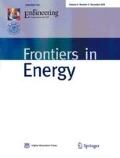Abstract
In pulverized coal particle combustion, part of the ash forms the ash film and exerts an inhibitory influence on combustion by impeding the diffusion of oxygen to the encapsulated char core, while part of the ash diffuses toward the char core. Despite the considerable ash effects on combustion, the fraction of ash film still remains unclear. However, the research of the properties of cenospheres can be an appropriate choice for the fraction determination, being aware that the formation of cenospheres is based on the model of coal particles with the visco-plastic ash film and a solid core. The fraction of ash film X is the ratio of the measuring mass of ash film and the total ash in coal particle. In this paper, the Huangling bituminous coal with different sizes was burnt in a drop-tube furnace at 1273, 1473, and 1673 K with air as oxidizer. A scanning electron microscope (SEM) and cross-section analysis have been used to study the geometry of the collected cenospheres and the effects of combustion parameters on the fraction of ash film. The results show that the ash film fraction increases with increasing temperature and carbon conversion ratio but decreases with larger sizes of coal particles. The high fraction of ash film provides a reasonable explanation for the extinction event at the late burnout stage. The varied values of ash film fractions under different conditions during the dynamic combustion process are necessary for further development of kinetic models.
Similar content being viewed by others
References
Chen J Y, Mann A P, Kent J H. Computational modelling of pulverised fuel burnout in tangentially fired furnaces. Symposium (International) on Combustion, 1992, 24(1): 1381–1389
Hottel H C, Stewart I M. Space requirement for the combustion of pulverized coal. Industrial & Engineering Chemistry, 1940, 32(5): 719–730
Hurt R, Sun J K, Lunden M. A kinetic model of carbon burnout in pulverized coal combustion. Combustion and Flame, 1998, 113(1-2): 181–197
Murphy J J, Shaddix C R. Effect of reactivity loss on apparent reaction order of burning char particles. Combustion and Flame, 2010, 157(3): 535–539
Field M A. Measurements of the effect of rank on combustion rates of pulverized coal. Combustion and Flame, 1970, 14(2): 237–248
Hurt R H, Mitchell R E. Unified high-temperature char combustion kinetics for a suite of coals of various rank. Symposium (International) on Combustion, 1992, 24(1): 1243–1250
Cloke M, Wu T, Barranco R, Lester E. Char characterisation and its application in a coal burnout model. Fuel, 2003, 82(15-17): 1989–2000
Niu Y, Shaddix C R. A sophisticated model to predict ash inhibition during combustion of pulverized char particles. Proceedings of the Combustion Institute, 2015, 35(1): 561–569
Lunden M M, Yang N Y C, Headley T J, Shaddix C R. Mineral-char interactions during char combustion of a high-volatile coal. Symposium (International) on Combustion, 1998, 27(2): 1695–1702
Niu Y, Liu S, Shaddix C R, Hui S. An intrinsic kinetics model to predict complex ash effects (ash film, dilution, and vaporization) on pulverized coal char burnout in air (O2/N2) and oxy-fuel (O2/CO2) atmospheres. Proceedings of the Combustion Institute, 2019, 37(3): 2781–2790
Chen C, Kojima T. Single char particle combustion at moderate temperature: effects of ash. Fuel Processing Technology, 1996, 47(3): 215–232
Niu Y, Wang S, Shaddix C R, Hui S. Kinetic modeling of the formation and growth of inorganic nano-particles during pulverized coal char combustion in O2/N2 and O2/CO2 atmospheres. Combustion and Flame, 2016, 173: 195–207
Niu Y, Liu X, Wang S, Hui S, Shaddix C R. A numerical investigation of the effect of flue gas recirculation on the evolution of ultra-fine ash particles during pulverized coal char combustion. Combustion and Flame, 2017, 184: 1–10
Fenelonov V B, Mel’gunov M S, Parmon V N. The properties of cenospheres and the mechanism of their formation during hightemperature coal combustion at thermal power plans. Kona Powder and Particle Journal, 2010, 28(0): 189–208
Żyrkowski M, Neto R C, Santos L F, Witkowski K. Characterization of fly-ash cenospheres from coal-fired power plant unit. Fuel, 2016, 174: 49–53
Yu J, Li X, Fleming E, Meng Z,Wang D, Tahmasebi A. Analysis on characteristics of fly ash from coal fired power stations. Energy Procedia, 2012, 17: 3–9
Vassilev S V, Vassileva C G. Mineralogy of combustion wastes from coal-fired power stations. Fuel Processing Technology, 1996, 47(3): 261–280
Li Y, Wu H. Ash cenosphere from solid fuels combustion. Part 1: an investigation into its formation mechanism using pyrite as a model fuel. Energy & Fuels, 2012, 26(1): 130–137
Li Y, Gao X, Wu H. Further investigation into the formation mechanism of ash cenospheres from an Australian coal-fired power station. Energy & Fuels, 2013, 27(2): 811–815
Raask E. Mineral Impurities in Coal Combustion: Behavior, Problems, and Remedial Measures. New York: Hemisphere, 1985
Ranjbar N, Kuenzel C. Cenospheres: a review. Fuel, 2017, 207: 1–12
Kolay P K, Bhusal S. Recovery of hollow spherical particles with two different densities from coal fly ash and their characterization. Fuel, 2014, 117(Part A): 118–124
Ngu L L, Wu H, Zhang D K. Characterization of ash cenospheres in fly ash from Australian power stations. Energy & Fuels, 2007, 21(6): 3437–3445
Niu Y, Gong Y, Zhang X, Liang Y, Wang D, Hui S. Effects of leaching and additives on the ash fusion characteristics of high-Na/Ca Zhundong coal. Journal of the Energy Institute, 2019, 92(4): 1115–1122
Acknowledgements
This work was supported by the National Natural Science Foundation of China (Grant No. 51776161), the Natural Science Basic Research Plan in Shaanxi Province of China (Grant No. 2018JQ5010), the Fundamental Research Funds for the Central Universities, and the Key Laboratory of Renewable Energy Electric-Technology of Hunan Province (Changsha University of Science & Technology, Grant No. 2017ZNDL003).
Author information
Authors and Affiliations
Corresponding author
Rights and permissions
About this article
Cite this article
Liu, S., Niu, Y., Wen, L. et al. Experimental studies of ash film fractions based on measurement of cenospheres geometry in pulverized coal combustion. Front. Energy 15, 91–98 (2021). https://doi.org/10.1007/s11708-020-0806-9
Received:
Accepted:
Published:
Issue Date:
DOI: https://doi.org/10.1007/s11708-020-0806-9



